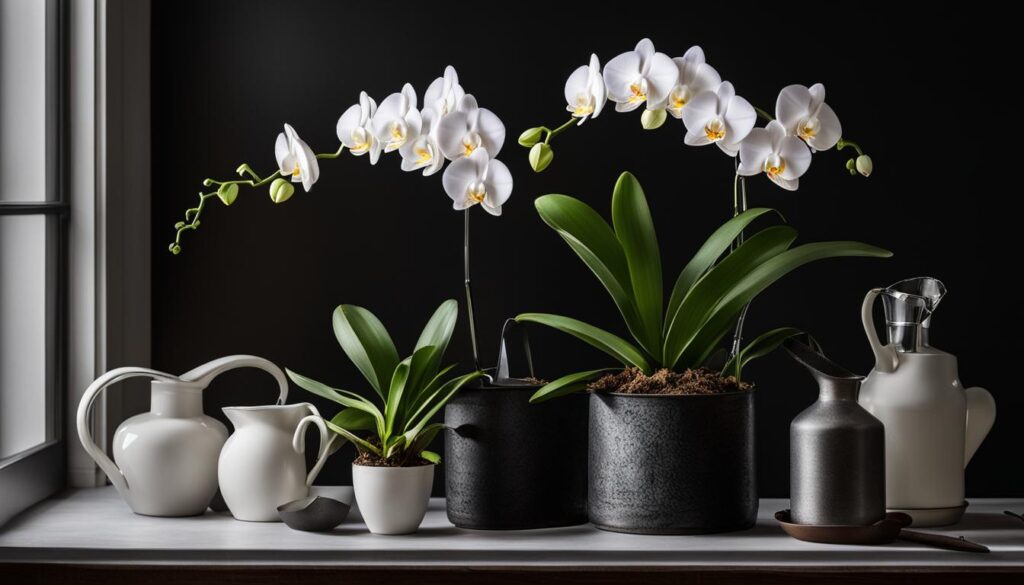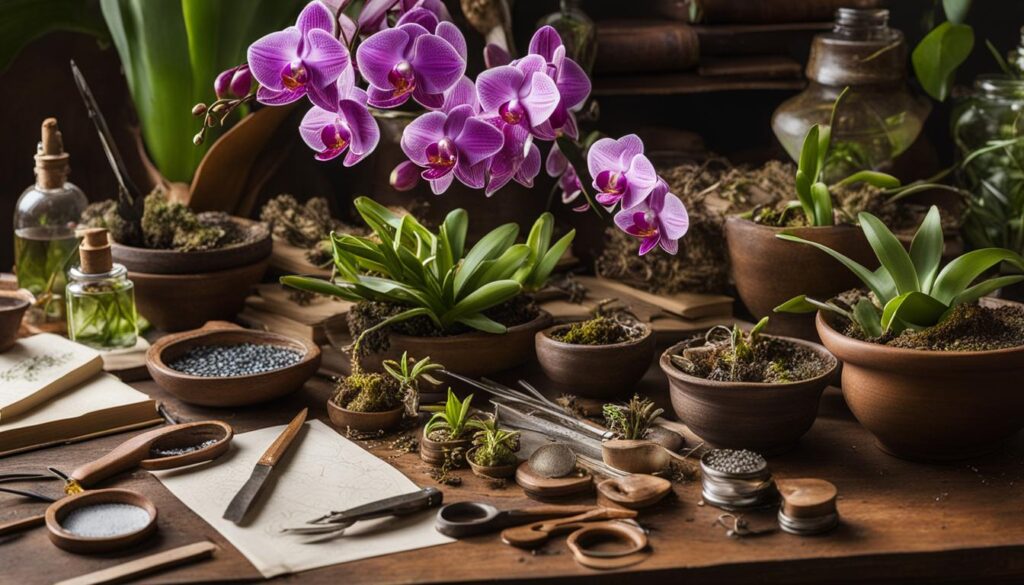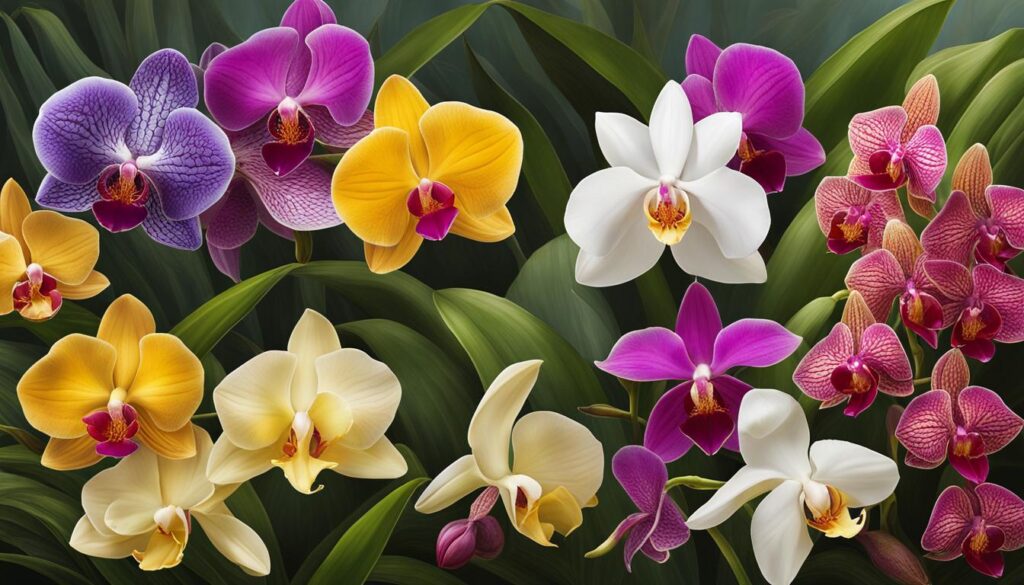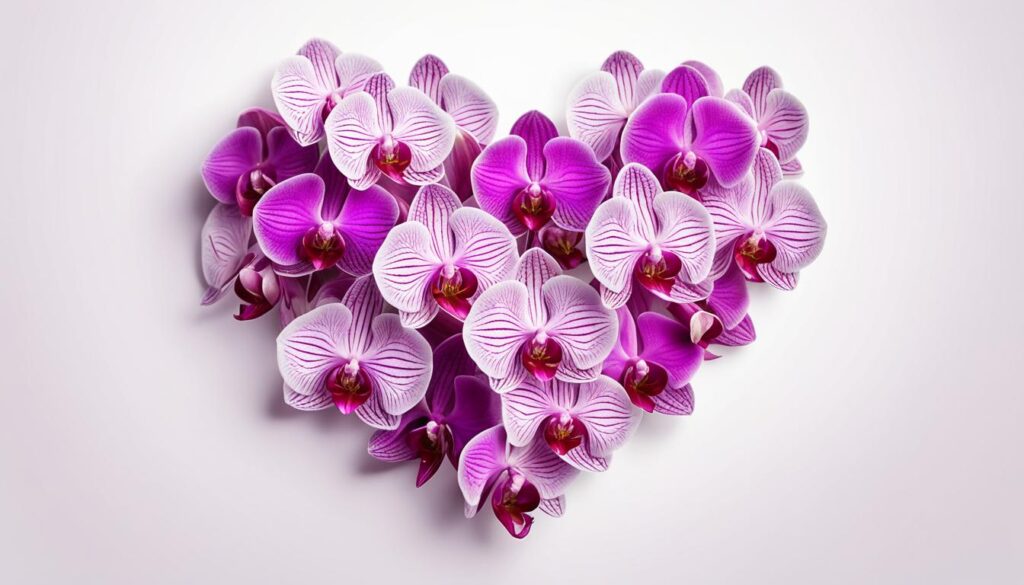Orchids are one of the largest and most diverse families of flowering plants, with over 25,000 species and more than 100,000 hybrids and cultivars.
Being a devoted orchid lover, I have spent countless hours engrossed in the vast array of orchid species outlined in the comprehensive orchid encyclopedia.
There is an undeniable allure in perusing its pages teeming with exotic flora and detailed care tips that incites my curiosity to delve deeper into the world of orchids.
Consulting this extensive guide never fails to provide me with valuable insights on nurturing orchids, a skill I strive to perfect in order to keep my own collection flourishing.
Despite their delicate and intricate nature, I have discovered that cultivating orchids at home can actually be quite attainable—with the right resources available, of course.
The abundance of knowledge I have acquired from various orchid societies and literature has greatly enriched my understanding of effectively caring for these magnificent blooms.
Key Takeaways
- Discover the vast array of orchid species through comprehensive orchid encyclopedias.
- Gain essential knowledge on maintaining and nurturing orchids properly.
- Explore the beauty and intricacies of growing orchids at home.
- Learn about the valuable resources available for both beginner and advanced orchid enthusiasts.
- Understand the significance of community and expert guidance in the world of orchid care.
Discovering the Diversity of Orchid Species
As an ardent enthusiast of orchids, I’ve always been captivated by the sheer diversity these marvelous plants offer. It’s truly a privilege to uncover the varied types of orchids, each with its own story, etched into the petals and leaves that define their unique identities. Let’s delve into the fascinating world of orchid taxonomy and indulge in the beauty of these natural masterpieces.
The Fascinating World of Orchids
From the lush rainforests to the arid deserts, orchids have conquered every imaginable habitat. With more than 25,000 documented types of orchids, their adaptability is unparalleled. My exploration through countless orchid plant varieties has revealed the resilience and evolutionary ingenuity of these plants.
Understanding Orchid Botany and Classification
Embarking on a journey of orchid botany unveils a complex world where beauty meets scientific rigor. The orchid classification system unravels the intricate relationships among species, helping me appreciate the nuances that distinguish a Phalaenopsis from a Cattleya.
Popular Orchid Types You Should Know
Among the myriad options, certain popular orchid types have captured the hearts of enthusiasts worldwide. The delicate elegance of a Phalaenopsis, the exotic charm of a Dendrobium, and the grandeur of a Cymbidium are just a few that exemplify the beauty these plants possess. Below is a table that showcases a comparison of these beloved orchids.
| Orchid Variety | Light Needs | Watering Frequency | Preferred Humidity | Bloom Season |
|---|---|---|---|---|
| Phalaenopsis | Low to medium | Once a week | 50-70% | Late winter to spring |
| Dendrobium | Medium to high | Every 3-4 days | 50-60% | Various times |
| Cymbidium | Bright, indirect | Every 10 days | 40-60% | Autumn to winter |
A Beginner’s Guide to Orchid Care Tips
Delving into the world of orchid gardening, I’ve discovered that the beauty of these plants is matched only by the satisfaction that comes from nurturing them.
Understanding orchid care tips is the key that unlocks the potential of these enchanting flowers.
What I’ve found most helpful is approaching orchid care as both a science and an art. It begins with the basics, light, water, temperature, and air circulation. By closely mimicking their natural tropical habitats within our homes, success in orchid gardening is much more likely. Despite the intricacies involved, the beginner’s journey to orchid care need not be daunting.
To facilitate a clearer understanding, let’s consider the primary care categories for orchids:
- Watering frequency and technique
- Light requirements and considerations
- Proper potting media and fertilization
- Temperature and humidity control
Every type of orchid has its own specific needs, but there are general guidelines that can be followed to ensure that these beguiling plants not only survive but thrive. Let’s put these categories into an easy-to-follow table for reference:
| Care Aspect | Description | Beginner’s Tip |
|---|---|---|
| Watering | Orchids require careful watering, avoiding over-saturation. | Use the ‘ice cube method’ for controlled watering or wait until the potting medium is dry to the touch. |
| Light | Bright, indirect sunlight is best for most orchid varieties. | Place near an east or south-facing window covered with a sheer curtain. |
| Potting Medium | Orchids thrive in loose, breathable materials like bark or moss. | Repot every 1-2 years to refresh the medium and encourage growth. |
| Temperature | Maintain a consistent temperature, favorable to the particular orchid species. | Keep away from draughts and direct heat sources such as radiators or heaters. |
| Humidity | Orchids favour a humid environment, reflecting their tropical origins. | Place a humidifier nearby, or set the pot on a tray filled with water and pebbles. |
While absorbing this information, I found it vital to temper expectations. The first foray into orchid care might come with setbacks, but each provides a valuable lesson that brings us closer to the ultimate goal, a blooming orchid garden, emanating tranquility and achievement.
I am confident that with these beginner’s guide to orchid care insights and the unwavering support found within the orchid community, anyone can embark on an orchid journey filled with growth and beauty.
The American Orchid Society and many other resources have laid the foundation for us to flourish alongside our cherished orchids.

Advanced Techniques in Orchid Plant Care
As I delve into the realm of advanced orchid plant care, I’ve discovered that the American Orchid Society (AOS) is a treasure trove of resources, quintessential for fine-tuning my gardening skills.
Sophisticated care goes beyond watering schedules and suitable soil mixes; it involves an in-depth understanding of the various threats such as pests and diseases, and the unique environmental requirements of different orchid species.
Let’s explore the instrumental resources AOS provides to enrich our orchid care expertise.
Navigating the AOS Video Library for Expert Advice
The AOS Video Library is an unparalleled asset for dedicated orchid enthusiasts. Whenever I face an unprecedented orchid conundrum, I find solace in their extensive collection of tutorials and seminars.
Experts discuss various challenges and advanced techniques in orchid care, offering solutions rooted in extensive experience and knowledge. I particularly appreciate the focus on sustainable care practices and innovative methods to encourage vigorous growth and blooming.
Orchid Pests and Diseases Management Webinars
One of the more daunting aspects of orchid care is the management of pests and diseases. It’s a topic that requires meticulous attention, and the AOS doesn’t disappoint.
Their webinars, led by esteemed experts in the field, provide crucial insights into identifying and combating the most stubborn of orchid ailments.
The practical advice gleaned from these webinars has been instrumental in preserving the health and beauty of my precious orchids.
Translating Orchid Culture with AOS Culture Sheets
The AOS Culture Sheets have been my go-to guide for understanding the specific needs of various orchid species. These sheets, succinct yet comprehensive, demystify the intricacies of orchid care.
From water requirements to light preferences, they capture all the crucial details that help translate complex information into actionable steps for optimal orchid culture.

Through these invaluable resources, my journey in advanced orchid plant care has become profoundly rewarding. Whether I’m combating an infestation maliciously eyeing my orchids or curating the ideal environment for a rare species, it’s clear that with the right knowledge and tools, any orchid enthusiast can cultivate a thriving orchid collection. Indeed, advanced care is the crux of achieving the purest form of horticultural artistry.
Orchid Gardening: Creating Your Own Oasis
The art of orchid gardening offers a compelling escape from the hustle and bustle of daily life.
What begins as a simple interest in growing orchids at home can quickly bloom into a full-fledged passion, spawning a lush sanctuary brimming with the vibrant colors and exotic aromas of orchid plants.
For me, the journey to create an orchid oasis has been a path to tranquility; a way to intertwine nature’s beauty with the comforts of home.
Whether you’re nurturing your orchids on a sunny kitchen ledge or beneath the filtered light of a greenhouse, every new leaf and bud brings a sense of accomplishment and inner peace.
It’s a hobby that has elevated to a form of meditation, a personal retreat where every orchid adds to the tapestry of my at-home haven.
Orchid gardening isn’t just about the plants; it’s about crafting an environment that replenishes your spirit.
As each plant thrives and flourishes, I’m reminded of life’s simple joys and the rewards of patience and dedication.
With each new species, whether a bold Cattleya or a delicate Masdevallia, my oasis evolves, reflecting not only the diversity of these enchanting species but also the growing depth of my own gardening experience.

Fostering a welcoming environment for these elegant blooms starts with understanding the unique needs of each orchid.
From the specific humidity requirements to the intricacies of their light and temperature preferences, every detail is crucial for your orchids to thrive.
Submerge yourself in the experience; let your senses guide you as you adjust elements to complement your orchids’ growth, and watch as your personal sanctuary unfolds.
- Lighting: Orchids require varying levels of light, from bright, indirect sun to lower levels for those species used to the understory of a forest.
- Watering: While overwatering is a common pitfall, proper moisture is vital for orchids, mimicking the epiphytic or terrestrial environments they originate from.
- Temperature: Orchids can be quite particular about their warmth, with some thriving in cozy indoor climates and others needing cooler drafts to signal their blooming cycle.
- Companionship: Orchids don’t flower in isolation in the wild, so consider companion planting to replicate the symbiotic relationships they naturally have.
In my orchid oasis, I’ve learned that these are not just flowers; they’re living sculptures, timeless artworks created by Mother Nature herself.
And in the heart of my orchid oasis, amidst their transcendent blooms, I find my inner serenity mirrored back at me, reflecting the joy and serenity that orchid gardening has brought into my life.
The Best Orchid Species for Home Gardeners
As a home gardener myself, I’ve encountered numerous orchids that not only survive but thrive indoors. In this rich botanical journey, I’ve realized that certain orchid species stand out as the best orchid species for home cultivation.
Catering to orchids for beginners and seasoned enthusiasts alike, these varieties are favored for their resilience and stunning beauty, making them perfect orchid species for home environments.
Here’s a look at some species that could beautifully accentuate your home garden.
| Orchid Species | Flowering Time | Light Requirements | Watering Frequency |
|---|---|---|---|
| Phalaenopsis (Moth Orchid) | Winter to Spring | Low, indirect | Once a week |
| Cattleya | Late Spring to Fall | Moderate to bright, indirect | Every 5-7 days |
| Dendrobium | Winter to Spring | Bright, indirect | Every 3-4 days |
| Oncidium (Dancing Lady) | Fall to Spring | Bright, indirect | Every 7-10 days |
| Miltonia (Pansy Orchid) | Spring to Fall | Lowe to moderate, indirect | Every 5-7 days |
If you’re venturing into the enchanting world of orchids, these best orchid species are ideal starters. They are generally forgiving and adapt well to the relatively stable conditions of a home environment.
Home gardeners can enjoy the gratification of nurturing these exquisite blooms without the necessity of a greenhouse or specialized structures.
Remember: The key to success in orchid care is to replicate their natural habitat to the best of your ability. This approach encourages healthy growth and abundant blooms.
Whether you’re attracted to the elegant arches of Phalaenopsis, the sun-drenched hues of Cattleya, or the whimsical dance of Oncidium, starting with these robust varieties will offer a solid foundation for your indoor oasis.
The innate beauty that each orchid brings to your space is incomparable, and as I have found in my own experience, deeply gratifying.

Embracing orchids as part of your indoor flora creates a serene ambiance that is both refreshing and aesthetically appealing.
Welcome, these marveled species into your home, and watch your personal garden flourish with vibrancy and life.
Exploring the Intriguing History of Orchids
As an orchid enthusiast, I’ve often marveled at how the history of orchids has intertwined with human culture. It’s a journey that transcends the simple beauty of these blooms and delves into a rich narrative where tropical orchids began their voyage from exotic jungles to beloved household plants.
Their remarkable cultivation has been meticulously developed over centuries, transitioning from the wild into our living quarters with grace and elegance.

The Journey of Tropical Orchids to Modern Cultivation
I’ve discovered that tropical varieties didn’t just find their way to our homes overnight. This phenomenon is rooted in the passionate pursuits of 19th-century orchid collectors, whose devotion led to the botanical exploits that supplied aristocratic conservatories.
Their journeys across continents to hunt down the rarest specimens are legendary, proving to shape and define our contemporary practice of orchid care.
How Orchids Have Influenced Cultures and Collectors
It’s not merely the cultivation of orchids that captures my fascination, but also the orchid influence across varied cultures. From art to mythology, these flowers have symbolized everything from love to luxury.
Delving deeper, I’ve learned about orchid societies and the incredible community of growers who treasure these plants.
Their stories, as diverse as the orchids themselves, are a testament to the profound bond between orchids and those who grow them.
“The orchid’s ability to captivate doesn’t rest in its visual appeal alone, but in the stories that each petal holds, a panorama of history and humanity interwoven with its roots.”
| Century | Contribution to Orchid History | Impact on Cultivation & Society |
|---|---|---|
| 19th | Orchid hunting expeditions | Establishment of orchids as symbols of opulence |
| 20th | Hybridization advancements | Diversification and increased accessibility for hobbyists |
| 21st | Technological improvements in cultivation | Global community of orchid enthusiasts interconnected through advancements in information sharing |
Cultivating these botanical wonders has taught me more than simply the necessities of care, it has allowed me to appreciate their storied past and the shared human history.
Orchids aren’t just a part of our gardens; they’re a part of our heritage.
Orchids: A Symbol of Love, Peace, and Happiness
As someone who’s followed the beckoning calls of numerous blossoms, I find that orchids symbolize a profound beauty that speaks directly to the soul.
It’s no secret within the orchid community that these exquisite flowers are more than just a visual delight; they represent love, acting as ambassadors of affection in every petal’s embrace.
Tranquility seems to blossom wherever orchids reside, insinuating peace into the lives of those who nurture them. And isn’t it a joy unparalleled, the happiness that flourishes from witnessing an orchid’s bloom?

Within the rich tapestry of the orchid community, beginners and seasoned orchid enthusiasts alike share a common thread, a passion for these enchanting plants.
When you step into the vibrant sphere of orchid collectors, you’re not just stepping into a hobby; you are entering a world where every conversation potentially weaves a new connection, a friendship sparked by mutual admiration for orchids.
I’ve discovered that orchid enthusiasts often gather around table discussions, exchanging cultivation tips and heartfelt stories of their orchid adventures. Here’s a glimpse of those collective insights:
| Orchid Trait | Symbolism | Community Wisdom |
|---|---|---|
| Vibrant Colors | Expression of Joy | “Keep your orchids in high light to maintain vibrant colors. They’re like smiles from nature, lifting our spirits.” |
| Delicate Structure | Elegance and Grace | “Orchids teach us patience and attentiveness, gently guiding us to find beauty in subtlety.” |
| Varied Species | Diversity and Adaptability | “The diversity among orchids is astounding. It’s a reminder that there’s a place for everyone in this community.” |
| Fragrance | Lasting Impact | “Just as an orchid’s fragrance lingers, so does the impact of a kind word or a shared tip within our circle.” |
Orchids have a captivating way of representing the myriad facets of love—from the youthful excitement of budding romance to the enduring strength of familial bonds. And I believe that’s what makes being part of the orchid community so enriching.
As we cultivate these symbols of love, peace, and happiness, they, in turn, cultivate us.
Growing Orchids at Home: From Windowsill to Greenhouse
Embarking on the journey of growing orchids at home can be a deeply rewarding venture that spans a variety of cultivation environments.
Whether you’re starting with a single orchid on your windowsill or managing a full-fledged orchid greenhouse, the experience is teeming with learning opportunities and delightful discoveries.
I’ve personally found that each nook of my home can be thoughtfully utilized to compliment the needs of various orchid species.

Choosing the Right Environment for Your Orchid
With so many diverse types of orchids, each requiring specific conditions to thrive, it’s vital to create the right orchid environment.
I recommend observing the natural habitat of your orchids to emulate those conditions as closely as possible within your own space.
Here’s how I’ve transformed my living quarters into a haven for different orchids:
- Phalaenopsis: These beauties love the moderate conditions of my living room. Set on an east-facing windowsill, they soak up the gentle morning light.
- Cymbidiums: Since they need cooler temperatures, I keep them near a drafty window where they can enjoy the temperature fluctuations.
- Dendrobium: With their high light requirements, these are perfect for my brightest spot—a south-facing windowsill shielded by a sheer curtain.
Sharing the Joy of Orchids with the Next Generation
My love for orchids isn’t just about personal enjoyment; it’s also about passing down this passion to the next generation. Just as the American Orchid Society’s KIDS’ CORNER educates and excites young minds about these magnificent plants, I’ve involved my own children in orchid care.
Together, we’ve embarked on fun projects, like creating a miniature orchid greenhouse, which not only teaches them about botany but instills a sense of ecological responsibility.
| Orchid Species | Window Type | Greenhouse Adaptation | Child-Friendly Learning Aspect |
|---|---|---|---|
| Phalaenopsis | East-facing, shaded | Not necessary | Learning about flowering cycles |
| Cymbidium | Cool, drafty | Yes, with temperature control | Understanding seasonal temperature needs |
| Dendrobium | South-facing, bright | Yes, with additional light supplement | Studying light requirements and photosynthesis |
Embracing the World of Orchids: A Summary
In my journey with orchids, I’ve been both a student and teacher, eternally immersed in the art of orchid plant care.
ach day brings new insights into the types of orchids, careful nurturing methods, and the shared wisdom from the community that’s wrapped around these enchanting blooms like a delicate vine.
The American Orchid Society has been my compass and companion, offering a repository of knowledge for every stage of orchid gardening.
From the novice excitedly planting their first Phalaenopsis to the expert fine-tuning the growth of rare species, successfully growing orchids at home is a dance of patience and passion.
The society’s orchid care tips, stemming from both science and a deep-rooted love for these plants, have guided me through each step.
And the joy is continuous, as fellow enthusiasts are always eager to share stories and support, enhancing the experience of cultivation.
The beauty of this journey is not merely in witnessing a bloom but in the cultivation of an inner garden, where joy, serenity, and beauty grow in tandem with the orchids themselves.
It’s in this spirit I tend to my orchid garden—an ever-evolving sanctuary in the comfort of my home.
FAQ
What is an orchid encyclopedia and why is it useful?
An orchid encyclopedia is a comprehensive resource that provides information on different orchid species, their botany, classification, and how to care for them. It’s useful for learning about the wide variety of orchids and for guidance on growing orchids at home.
Can you recommend some popular orchid types for beginners?
Absolutely! Some popular orchid types that are considered good for beginners include the Phalaenopsis, commonly known as the “Moth Orchid,” the Cymbidium, and the Dendrobium orchid. These varieties tend to be more forgiving and easier to care for.
How can I learn more about the botany and classification of orchids?
You can learn more about the botany and classification of orchids by visiting the American Orchid Society’s website, browsing their ORCHID CARE section, watching their videos, and checking out orchid encyclopedias and books dedicated to orchids…and of course by reading my articles on this website.
What are some key orchid care tips for beginners?
Key orchid care tips include understanding the specific light, water, and temperature needs of your orchid, ensuring proper drainage, and using the right soil mix. It’s also important to fertilize your orchids appropriately and watch out for signs of pests or disease.
What advanced techniques can I learn for orchid plant care?
For advanced orchid plant care, you can explore topics like repotting, advanced fertilization techniques, pest and disease management, and specific climate controls for different orchid varieties. The American Orchid Society’s Video Library and webinars are great resources for this kind of information.
How can I create my own orchid oasis at home?
To create your own orchid oasis, choose a space with adequate light and temperature control, select orchid species that match your environment, and arrange them aesthetically. It’s about personalizing your space to create a tranquil area where your orchids can thrive.
Which orchid species are best suited for home gardeners?
The best orchid species for home gardeners often include the Phalaenopsis, Oncidium, and Paphiopedilum, as they can easily adapt to indoor conditions. But the right choice depends on your home’s environment and how much care you can provide.
How have orchids influenced cultures and collectors over the years?
Orchids have influenced various cultures through their use in art, literature, and celebrations. They’re seen as symbols of beauty, luxury, and status. For collectors, orchids represent a meaningful hobby that connects them with a community of fellow enthusiasts.
What do orchids symbolize?
Orchids often symbolize love, beauty, fertility, and strength. Specific colors can convey different meanings—white orchids typically represent innocence and purity, while purple orchids symbolize admiration and respect.
What is the best environment for growing orchids at home?
The best environment for growing orchids at home varies depending on the type of orchid. Generally, they require a humid, well-ventilated area with indirect sunlight. A windowsill with sheer curtains or a greenhouse can provide ideal conditions for many species.
How can I involve the next generation with orchid care?
You can involve the next generation with orchid care by engaging them in the potting process, taking them to orchid shows, or by using resources like the American Orchid Society’s Kids’ Corner to educate them in a fun and interactive way.
Where can I find accurate information on orchid plant care?
Accurate information on orchid plant care can be found through reputable sources such as the American Orchid Society, specialized orchid care books, authoritative gardening websites, and by connecting with local orchid societies or clubs….and of course by signing up to my newsletter and reading my articles on this website.


Leave a Reply